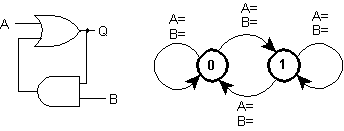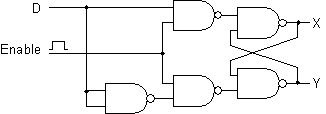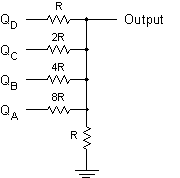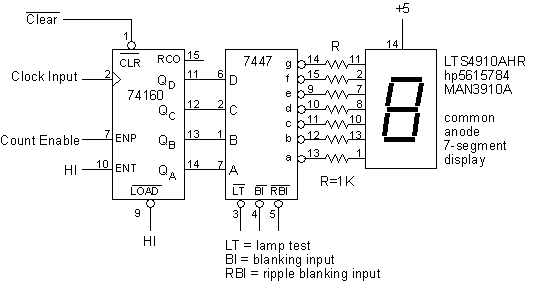
A time-state diagram for a single variable illustrates the two possible outcomes, 0 and 1, for all possible input conditions. In some cases, not all paths are available. In the problems below, complete the time-state diagrams first before proceeding to the truth-table.
Construct the circuit shown using a 7432 OR gate. Analyze the operation of this circuit and complete the time-state diagram and truth-table. What is a possible use for this circuit?

Construct the circuit shown and analyze its operation. Complete the time-state diagram and truth-table. Explain the function of the AND gate and what input B does. What is this circuit called? Can you think of any uses for this circuit?

Using DeMorgan's theorems show that this circuit is equivalent to the circuit from Problem 2. Complete the time-state diagram and truth-table.

Construct the clocked R-S flip-flop shown and analyze the operation of this circuit with reference to the truth-table from Problem 3. The clock pulse is to be provided by a push button. Complete the truth-table.

| The last line in the truth-table requires some extra thought. |
Construct the D-type latch shown below and analyze the operation of the circuit. Compare the operation of this circuit with the previous circuit. Complete the truth-table.

Construct a 4-bit binary asynchronous (ripple) counter using four stages of T-type flip-flops.
Connect the output of each stage to an LED and test the operation of the counter using the clock pulse generated by a push button. Explain why this operation is irratic and show how you would correct this problem.
Create an oscillator circuit and use its output as a clock input to the counter. Begin with a low clock frequency so that the flashing lights are discernible. Next, choose a high clock frequency and examine the output waveforms at each stage. Draw the timing diagram.

Construct a simple digital-to-analog converter (DAC) by adding the resistor network to the output of the 4-bit
binary counter as shown.
For simplicity, use the following resistor values:
|
R |
= |
100 ohms |
|
2R |
= |
220 ohms |
|
4R |
= |
470 ohms |
|
8R |
= |
1000 ohms |
With the oscillator clocking the counter as in the previous exercise, observe the output analog voltage on the oscilloscope. Explain how this DAC works by deriving the analog voltage V(QD,QC,QB,QA) as a function of the binary values QD, QC, QB, QA.
Design and build a 4-bit BCD (Binary Coded Decimal) synchronous counter using two 7476 dual J-K flip-flop packages. Test your circuit using a low frequency clock and examine the outputs via the LEDs. Using a high frequency clock observe the waveforms and draw the timing diagram.
Design and build a 4-bit serial shift register using 7476 flip-flops. Using the same circuit, configure the feedback loop to create (a) a ring counter, (b) a switch-tail counter.
Design and build a time-interval gate which outputs a logic HI between the first and second input events. The output reverts to LO following the second event and any subsequent event and stays low until it is re-enabled. This circuit is used as a gate to a clock circuit in order to measure the time interval between two events. Practise systematic design procedures as follows:
Construct a single digit decimal counter and 7-segment LED display as shown. Test your circuit using a push button. Next, use a low frequency clock. Can you think of any applications for this circuit.

| When laying out your circuit, make sure that the current limiting resistors are neatly organized and not shorting. An accidental short to GND or logic LO can easily burn out the LED display. |
Design a 2-digit rate or frequency meter that displays from 0 to 99 the rate of input events. This circuit can be utilized to create simple meters such as a radiation detector, CO monitor, heart-rate monitor, tachometer, etc. Use the systematic design approach to system design by taking the following steps: